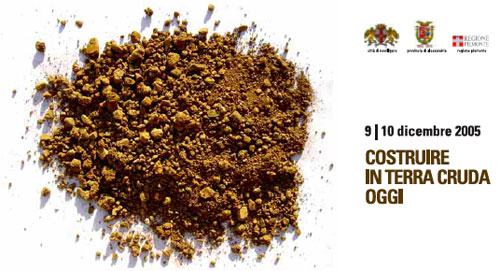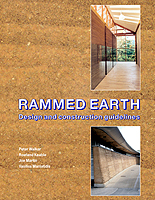The Columbus house, built by Christopher Columbus in 1493 and made of rammed earth and cut limestone, is the oldest remnant of a European structure in the Americas.
Rammed Earth is for Everyone
Rammed Earth is for Everyone, claims this new blog devoted to rammed earth. Good bibliographies and examples of soil mockups.
Earthen Architecture Association
The Earthen Architecture Association, headquartered in the Czech Republic, is an organization whose members are interested in Earthen Architecture and natural materials, promotes use of clay in new buildings and protection and preservation of existing clay houses as a part of our cultural heritage.
Earth Ammunition
In the ruins of an ancient mud-brick city in northeastern Syria, archaeologists have uncovered what they say is substantial evidence of a fierce battle fought there in about 3500 B.C., which includes the discovery of 120 clay balls that were meant to be fired from slings, as well as 1,200 smaller “bullets.”
Rammed Earth at MIT
A team of MIT architecture students built a wall behind the MIT Museum of rammed earth using a combination of 30 percent Boston Blue Clay mixed with sand and gravel. Twelve tons of this clay, common at depths of 30 to 60 feet in the metropolitan Boston area, came from the excavation site of a new building at Harvard. “The wall will serve as a long-term test of rammed earth in New England, allowing us to observe the way various soil types used in construction stand up to the climate,” said Joe Dahmen, a graduate student in architecture who is leading the project. [ more at livescience ]
Virtual Mud

Heinz Ruther, professor of Geomatics at the University of Cape Town, has embarked on a project aimed both at preserving the sites, and also at making them accessible – in virtual form – to people across the continent who may not have the means to get there themselves. BBC | Africast [via]
Building with Earth Conference

Building with Raw Earth Today: International Conference on the Preservation, Promotion and Protection of Earth Architecture. December 9-10, 2005. Download conference schedule [Italian Language]
The Complete Works of Hassan Fathy

An Architecture for People: The Complete Works of Hassan Fathy reviews the ideas and designs of Egyptian architect Hassan Fathy (1900-1989), best known for his striking Architecture for the Poor (University of Chicago, 1973), which described his efforts to create the village of New Gourna for 7,000 displaced Egyptian peasants known as the Gourni. Fathy sought to empathize with their lifeworld and to find architectural means whereby the new village would sustain their traditional way of life yet at the same time make life better by drawing on sustainable technology.
Steele, an architect himself, presents Fathy’s built projects and discusses the design philosophy underlying his work. Steele’s book is a tribute to Fathy as a compassionate designer and as a master craftsman who held strongly to traditional values and beliefs at a time when the historical amnesia and standardization of Modernist architecture dominated.
Node 1 and Contour Crafting
“Node 1” is a conceptual architecture project by French Architect François Roche which lacks most of the usual architectural accoutrements: blueprints, material suppliers, subcontractors. Instead, Roche imagines a programmable assembly device dubbed the “viab,” a construction robot capable of improvising as it assembles walls, ducts, cables, and pipes. A viab would produce structures that are not set and specific, but impermanent and malleable – merely viable – made of a uniform, recyclable substance like adobe.
The closest thing to a viab today is a modest mud-working robot, called “contour crafter”, invented by Behrokh Khoshnevis, a professor of engineering at the University of Southern California. Two years ago, California-based architect Greg Lynn was talking to Khoshnevis about the same topic. [ 1 | 2 | 3 ]
Rammed Earth: Design and Construction Guidelines

Rammed Earth: Design and Construction Guidelines by Peter Walker and BRE promotes the use of rammed earth wall construction in the UK as a high-quality and sustainable building technology. In one book it gives detailed practical guidance on architectural details, structural engineering recommendations, material selection, construction and maintenance of rammed earth.
